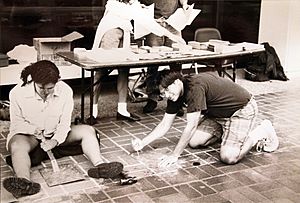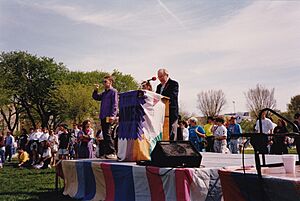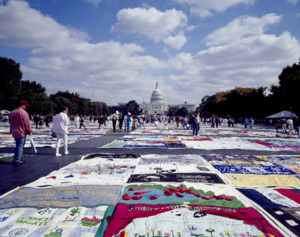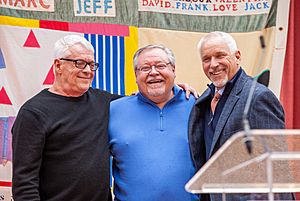NAMES Project AIDS Memorial Quilt facts for kids
| AIDS Memorial Quilt | |

AIDS Memorial Quilt on display at the
National Mall in Washington, D.C. |
|
| Location | Various locations during exhibitions; San Francisco (when not displayed). |
|---|---|
| Designer | Cleve Jones |
| Type | Community memorial arts project. |
| Material | Fabric and various materials. |
| Length | 1,300,000 sq ft (120,000 m2) |
| Beginning date | November 27, 1985 |
| Inauguration date | October 11, 1987 |
| Dedicated to | the people who have lost their lives to AIDS. |
| Website | Interactive AIDS Quilt |
| Friends, family members, or loved ones. | |
The NAMES Project AIDS Memorial Quilt is a special memorial. It celebrates the lives of people who died from AIDS-related illnesses. This quilt is huge, weighing about 54 tons. It is the largest piece of community folk art in the world.
The idea for the Quilt started in 1985. This was during the early years of the AIDS pandemic. At that time, many people who died from AIDS could not have funerals because of social stigma. The Quilt has been shown many times on the National Mall in Washington, D.C.. In 2020, it moved back to San Francisco. The National AIDS Memorial now takes care of it. You can even see parts of it online!
Contents
How the Quilt Started and Grew
The idea for the NAMES Project Memorial Quilt came from Cleve Jones. He was an AIDS activist. In 1985, he was at a candlelight march in San Francisco. This march remembered the 1978 deaths of San Francisco Supervisor Harvey Milk and Mayor George Moscone.
For the march, Cleve Jones asked people to write names of loved ones lost to AIDS. They taped these signs to the old San Francisco Federal Building. When Jones saw all the signs, they looked like a giant patchwork quilt. This gave him the idea.
The NAMES Project officially began in 1987 in San Francisco. Cleve Jones, Mike Smith, and many volunteers started it. Many people who died from AIDS did not have funerals. This was because of the social stigma around AIDS. Also, some funeral homes would not handle their remains. The Quilt became a way for people to remember and celebrate their loved ones. Volunteers made thousands of panels in a storefront on Market Street.
The Quilt is a memorial that celebrates lives. It helped change how memorials were designed. Each panel is 3 feet by 6 feet. This is about the size of a grave. This size connects the Quilt to the idea of remembering those who passed away.


First Public Display
The Quilt was first shown on October 11, 1987. It was during the Second National March on Washington for Lesbian and Gay Rights. This event took place on the National Mall. The Quilt had 1,920 panels and covered a huge area. It was bigger than a football field.
Forty-eight volunteers carefully unfolded the Quilt at sunrise. People read aloud the names on the Quilt. This became a tradition for future displays. About half a million people visited that weekend.
Quilt Tours and Exhibitions
The Quilt went on its first national tour in 1988. It raised almost half a million dollars. Over 9,000 volunteers helped. A team of seven people traveled, displayed, and added to the Quilt. New panels were added in each city. By the end of the tour, the Quilt had grown from 1,920 to over 6,000 panels.
In 1989, the Quilt toured 19 U.S. cities and 7 cities in Canada. This helped start the Canadian AIDS Memorial Quilt. By October, the Quilt had over 12,000 panels. It was shown again on The Ellipse in Washington, D.C..
In October 1992, the entire Quilt was displayed on Washington's National Mall. It had panels from every state and 28 countries. The Quilt was more than 10 times its original size. It had over 21,000 handmade panels. It stretched from the Washington Monument to the Lincoln Memorial.
The Quilt was also part of President Bill Clinton's inaugural parade in 1993. Over 200 volunteers marched with 90 Quilt panels.
In October 1996, the Quilt was displayed again on the National Mall. It stretched from the Washington Monument to the U.S. Capitol. Nearly 1.2 million people visited. Over 40,000 panels were shown. President Bill Clinton and First Lady Hillary Rodham Clinton attended. This was the last time the entire Quilt was shown on the Mall.
In June 2004, the Quilt had over 8,000 new panels. It was displayed on The Ellipse in Washington. This was to mark National HIV Testing Day.
For its 25th anniversary in July 2012, the Quilt returned to the National Mall. It had over 48,000 panels, honoring 94,000 lives. It was also shown at 50 other places in D.C. This was during the XIX International AIDS Conference. Because of its huge size, 1,500 panels were rotated daily at the Smithsonian Folklife Festival.
As of 2020, you can see the AIDS Memorial Quilt online. It has 50,000 panels with nearly 110,000 names. You can search for specific blocks or names. This lets you read the stories sewn into each panel.
In June 2022, the National AIDS Memorial celebrated the Quilt's 35th anniversary. They displayed 3,000 panels in Golden Gate Park. It was a moving tribute to those affected by AIDS.
Where the Quilt is Kept
In 1997, the NAMES Project moved its main office from San Francisco to Washington, D.C. In 2001, the quilt panels moved from San Francisco to Atlanta, Georgia. The NAMES Project Foundation was based in Atlanta.
In 2019, it was announced that the Quilt would return to San Francisco. The National AIDS Memorial now takes care of it. In 2020, its records were moved to the American Folklife Center at the Library of Congress. When the Quilt is not being shown, it is stored in San Francisco. It continues to grow. As of 2022, it has over 50,000 panels, remembering more than 110,000 people. It weighs about 54 tons.
Goals of the Quilt
The Quilt has important goals. It helps people understand how big the AIDS pandemic really is. It also offers support and healing to those affected by it. Another goal is to raise money for groups that help with AIDS prevention and education. By 1996, over $1.7 million had been raised. This effort continues today.
How the Quilt is Made and Cared For
Panels are usually 3 by 6 feet and made of fabric. They are created to remember someone who died from AIDS-related problems. People make panels alone or in workshops. For example, Call My Name focuses on African American representation. Quilting bees, like one at the 2012 Smithsonian Folklife Festival, also make panels.
The person making the panel chooses how to create it. Common methods include traditional fabric quilting, embroidery, applique, paint, stencils, beading, and iron-ons.
Panels can include many different items and materials:
- Fabrics like lace, suede, leather, mink, and taffeta. Also, Bubble Wrap, other kinds of plastic, and even metal.
- Decorations like pearls, quartz crystals, rhinestones, sequins, feathers, and buttons.
- Clothing, such as jeans, T-shirts, gloves, boots, hats, uniforms, jackets, and flip-flops.
- Personal items like human hair, cremation ashes, wedding rings, merit badges, awards, and car keys.
- Unusual items, such as stuffed animals, records, and bowling balls.
Panels are sent to the National AIDS Memorial. They come with a form from the panel-maker and a letter. Sometimes, other things like photos are sent too. All this information is saved in a database.
Panels are backed with canvas. Then, they are sewn together in blocks of eight. Holes are added for hanging. The blocks are numbered and photographed. The numbers help find them in storage, on the Quilt website, and when the Quilt is displayed.
Examples of Panels
People who submit panels do not have to know the person. But they should feel a connection and want to honor them. For example, many panels were made for Queen lead-singer Freddie Mercury. One was white with a blue and black guitar. It had "Freddy Mercury" written down the sides in black, with the AIDS ribbon. Another was purple silk with "Freddie Mercury," "Queen," and "1946–1991" in silver, plus two pictures of him.
Many panels were also made for actor Rock Hudson. One had a navy blue background with silver "Rock Hudson" and stars. It also had a rainbow with the word "Hollywood."
Other panels are made by loved ones. They are then joined to make one large block. Some panels are very colorful and bold. Others are more quiet and simple.
How the Quilt is Recognized
The Quilt has been recognized in many ways. Panels are part of the Smithsonian Institution National Museum of American History's collection. It was also featured in the book The Smithsonian's History of America in 101 Objects.
Awards and Documentaries
- The NAMES Project was nominated for a Nobel Peace Prize in 1989.
- In 2002, the NAMES Project Chicago Chapter joined the Chicago Gay and Lesbian Hall of Fame.
- The Quilt is the main topic of the 1989 documentary film, Common Threads: Stories from the Quilt. This film won a Peabody Award and an Academy Award. It was produced by Rob Epstein and Bill Couturié, and narrated by Dustin Hoffman.
Music and Television Inspired by the Quilt
- Songwriter Tom Brown wrote "Jonathan Wesley Oliver, Jr." about the Quilt in 1988.
- In 1990, John Corigliano's Symphony No. 1, inspired by the Quilt, was first performed.
- Elegies for Angels, Punks and Raging Queens is a song cycle from the late 1980s. Its songs and stories were inspired by the Quilt.
- In 1992, The AIDS Quilt Songbook premiered. It is a collection of new musical works about the impact of AIDS.
- Washington D.C.'s Different Drummers and the Lesbian and Gay Chorus of Washington asked composer Robert Maggio to create "Quilt Panels." It was first performed in 2003.
- The NAMES Project was the basis for the musical Quilt, A Musical Celebration.
- The Quilt was shown on the ABC Soap Opera "One Life to Live" in 1992.
- The AIDS Memorial Quilt was mentioned on the show General Hospital. The show raised money for AIDS research. A quilt block was made for the show's character, Michael "Stone" Cates, in 1996.
- In a 1999 A&E Biography, the AIDS Memorial Quilt was shown. It included footage from the National Mall.
- The Quilt is displayed in the last scene of the Showtime miniseries Fellow Travelers in 2023.
Other Projects Inspired by the Quilt
The AIDS Memorial Quilt was the first of its kind. It is a growing monument made by thousands of people. In 2007, it was the largest piece of community folk art in the world. The Quilt has inspired many other memorials and awareness projects.
Examples include:
- The K.I.A. Memorial Quilt, which remembers U.S. Armed Forces members killed in the Iraq War.
- After the September 11 attacks, several quilt projects were made to remember the victims. These include the September 11 Quilts Memorial Exhibition and America's 9-11 Memorial Quilts.
- Many other medical conditions now have quilts, such as:
- Huntington's disease
- Congenital heart disease
- Breast cancer
There are also quilts for specific groups affected by AIDS. These include quilts for Canada, Australia, and New Zealand. "Virtual" AIDS Memorial Quilts have also been created online.
During the COVID-19 pandemic, a Quilt volunteer named Gert McMullin made protective masks. She used quilting fabric for community service groups.
Current Display Location
In November 2019, the NAMES Project Foundation announced that the Quilt would move to San Francisco. The National AIDS Memorial now permanently cares for it. The Project's records were given to the American Folklife Center at the U.S. Library of Congress. This makes them easier for the public to access. This move brings the Quilt back to San Francisco, where it first began.
See also
 In Spanish: NAMES Project AIDS Memorial Quilt para niños
In Spanish: NAMES Project AIDS Memorial Quilt para niños
- Art of the AIDS Crisis
- New York City AIDS Memorial





